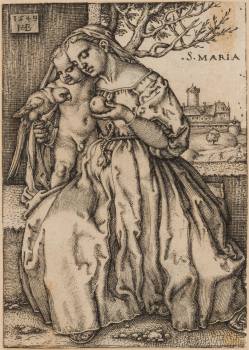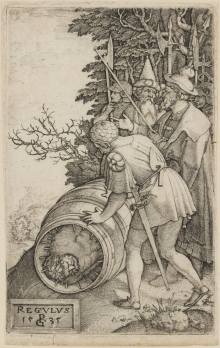In the first half of the 16th century, graphic art began to flourish especially in the south of Germany with the emergence of a generation of outstanding engravers of the Late Renaissance. Among them was a specific group known as the Little Masters, namely Georg Pencz, the Barthel and Sebald Beham brothers and Heinrich Aldegrever, as well as Virgil Solis and others. Although differing in style, they had in common the small size of their prints, which tends to be regarded as the main reason for their collective name. Many were followers and students of Albrecht Dürer, and the term Little Masters was also believed to suggest that despite their mastery they did not match his artistic grandeur.
For the most part, these were prolific artists who produced a large number of engravings and woodcuts in their workshops that illustrated biblical (both the Old and New Testaments) and mythological themes, as well as historical subjects, drawn particularly from Classical antiquity. They also created a range of symbolic motifs and frequently published prints depicting highly ornamental designs. Secular themes bordering on genre scenes were also very popular – notably images of dancing couples, feasts and rural brawls – oftentimes captured with a measure of naturalism and humour. In some of their prints, the artists openly adhered to the oeuvre of distinguished masters, above all Albrecht Dürer (but also, for example, Raphael) that they transposed into small-dimensional works, thus widely disseminating the masterpieces through the print medium.
This exhibition presents a selection of engravings and woodcuts from the superb and fairly large collection of graphic art by the Little Masters, housed in the National Gallery’s Collection of Prints and Drawings. Also on display are some of Albrecht Dürer’s works to which many of the small prints are closely related.
Curators: Alena Volrábová, Lenka Babická
Schwarzenberg Palace – The Graphic Arts Cabinet
For the most part, these were prolific artists who produced a large number of engravings and woodcuts in their workshops that illustrated biblical (both the Old and New Testaments) and mythological themes, as well as historical subjects, drawn particularly from Classical antiquity. They also created a range of symbolic motifs and frequently published prints depicting highly ornamental designs. Secular themes bordering on genre scenes were also very popular – notably images of dancing couples, feasts and rural brawls – oftentimes captured with a measure of naturalism and humour. In some of their prints, the artists openly adhered to the oeuvre of distinguished masters, above all Albrecht Dürer (but also, for example, Raphael) that they transposed into small-dimensional works, thus widely disseminating the masterpieces through the print medium.
This exhibition presents a selection of engravings and woodcuts from the superb and fairly large collection of graphic art by the Little Masters, housed in the National Gallery’s Collection of Prints and Drawings. Also on display are some of Albrecht Dürer’s works to which many of the small prints are closely related.
Curators: Alena Volrábová, Lenka Babická
Schwarzenberg Palace – The Graphic Arts Cabinet
1—1 / 5











